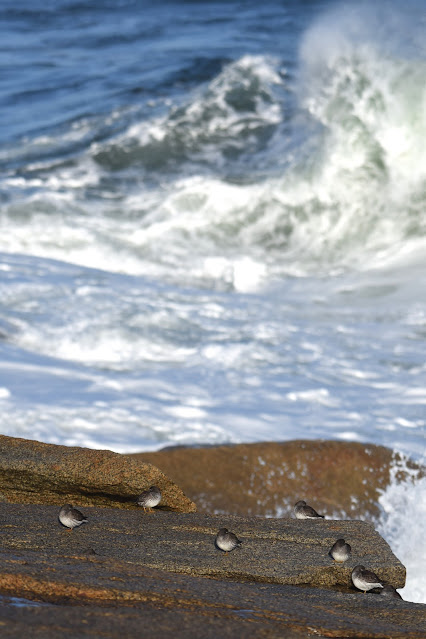Any encounter with a flock of Purple Sandpipers enlivens a
winter walk along the shoreline of Halibut Point. Their adaptation to this
environment is of course astonishing. If you happen to see them flying in
unison your sense of wonder will multiply.
 |
| Purple Sandpipers |
These birds present a most interesting combination of
individual skills and collective cohesion.
In an instant they can transform their self-oriented foraging pursuits
into aerial group dynamics.
Their explosions into collective flight have been measured
as occurring in 38 milliseconds, three times faster than a human eye blinks.
Once in the air they form a unit navigating as with one
mind.
Their cohesion, seemingly without vocalization
or other signals, has always defied human comprehension. Precise observation
has measured waves of movement traveling from bird to bird in 15 milliseconds
as the flock weaves and reconfigures in flight.
Explanations leave us more satisfied with the what than the how. The most accepted account was offered by zoologist Wayne Potts
in the journal Nature decades ago in 1984. He posited that
birds in flocks are able to change direction quickly not because they are following a
leader or their neighbors, but because they see a movement far down the line
and anticipate what to do next. Potts called this rippling
effect the chorus-line hypothesis with reactions propagating
through the flock at least three times faster than could be explained by birds just
watching their immediate neighbors.

The photograph above shows a lead
bird but not, I am assured by a leading naturalist, a flock leader. From a
lifetime of shorebird study he is convinced that sandpipers have no
decision-making leader even when they're relocating to another feeding ground
down the coast and re-settling together at a certain tide line. "They're
not deciding it," he says. "It reflects a group ambivalence. The
group as a whole knows what it's doing."
Sometimes understanding must be
satisfied with going beyond logic, particularly when processes happen quicker
than the blink of an eye. The mysteries of these birds enhance rather than
diminish our fascination. Purple Sandpipers have earned a niche not only on
improbable terrain but in the near-mythic landscape of human wonder.























